light SKODA SUPERB 2009 2.G / (B6/3T) Owner's Manual
[x] Cancel search | Manufacturer: SKODA, Model Year: 2009, Model line: SUPERB, Model: SKODA SUPERB 2009 2.G / (B6/3T)Pages: 294, PDF Size: 21.33 MB
Page 183 of 294
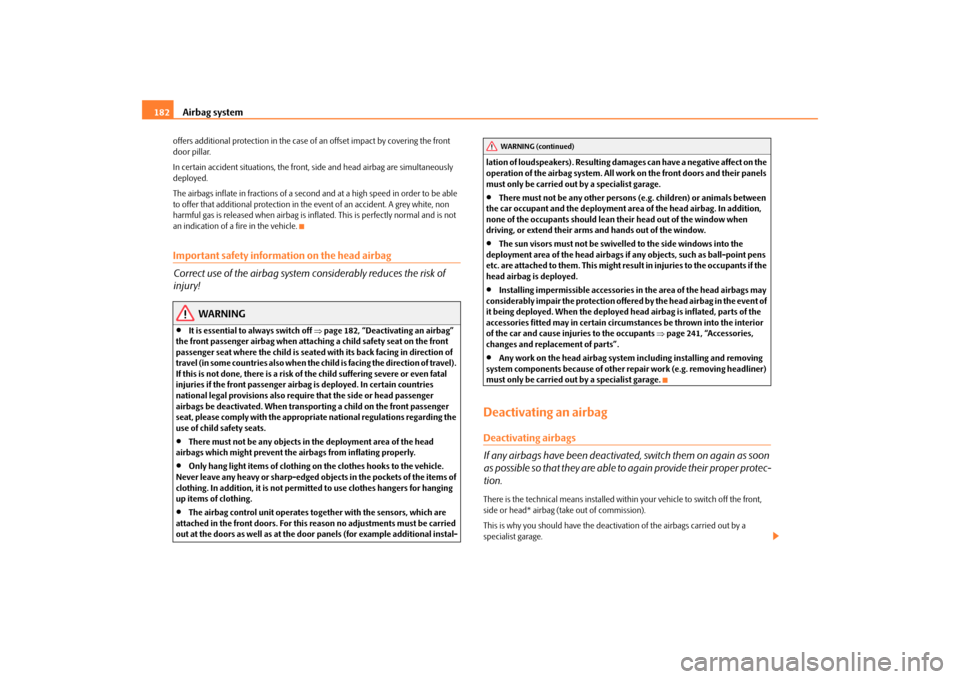
Airbag system
182
offers additional protection in the case of
an offset impact by covering the front
door pillar. In certain accident situations, the front,
side and head airbag are simultaneously
deployed. The airbags inflate in fractions of a second
and at a high speed in order to be able
to offer that additional protection in th
e event of an accident. A grey white, non
harmful gas is released when airbag is inflated. This is perfectly normal and is not an indication of a fire in the vehicle.Important safety information on the head airbag Correct use of the airbag system considerably reduces the risk of injury!
WARNING
•
It is essential to always switch off
⇒page 182, “Deactivating an airbag”
the front passenger airbag when attaching a child safety seat on the front passenger seat where the child is seated
with its back facing in direction of
travel (in some countries also when the ch
ild is facing the direction of travel).
If this is not done, there is a risk of the child suffering severe or even fatal injuries if the front passenger airbag
is deployed. In certain countries
national legal provisions also requir
e that the side or head passenger
airbags be deactivated. When transporting a child on the front passenger seat, please comply with the appropri
ate national regula
tions regarding the
use of child safety seats.•
There must not be any objects in the deployment area of the head
airbags which might prevent the airbags from inflating properly.•
Only hang light items of clothing on the clothes hooks to the vehicle.
Never leave any heavy or sharp-edged ob
jects in the pockets of the items of
clothing. In addition, it is not permitted to use clothes hangers for hanging up items of clothing.•
The airbag control unit operates to
gether with the sensors, which are
attached in the front doors. For this reason no adjustments must be carried out at the doors as well as at the door panels (for example additional instal-
lation of loudspeakers). Resulting dama
ges can have a negative affect on the
operation of the airbag system. All work on the front doors and their panels must only be carried out by a specialist garage.•
There must not be any other persons
(e.g. children) or animals between
the car occupant and the deployment area of the head airbag. In addition, none of the occupants should lean their head out of the window when driving, or extend their arms and hands out of the window.•
The sun visors must not be swivelled to the side windows into the
deployment area of the head airbags if any objects, such as ball-point pens etc. are attached to them. This might resu
lt in injuries to
the occupants if the
head airbag is deployed.•
Installing impermissible accessories in the area of the head airbags may
considerably impair the protection offere
d by the head airbag in the event of
it being deployed. When the deployed head airbag is inflated, parts of the accessories fitted may in certain circum
stances be thrown into the interior
of the car and cause injuries to the occupants
⇒page 241, “Accessories,
changes and replacement of parts”.•
Any work on the head airbag system including installing and removing
system components because of other repair work (e.g. removing headliner) must only be carried out by a specialist garage.Deactivating an airbagDeactivating airbags If any airbags have been deactivated, switch them on again as soon as possible so that they are able to
again provide their proper protec-
tion.There is the technical means installed within
your vehicle to switch off the front,
side or head* airbag (take out of commission). This is why you should have the deacti
vation of the airbags carried out by a
specialist garage.
WARNING (continued)
s2dk.1.book Page 182 Wednesday, April 8, 2009 12:23 PM
Page 184 of 294
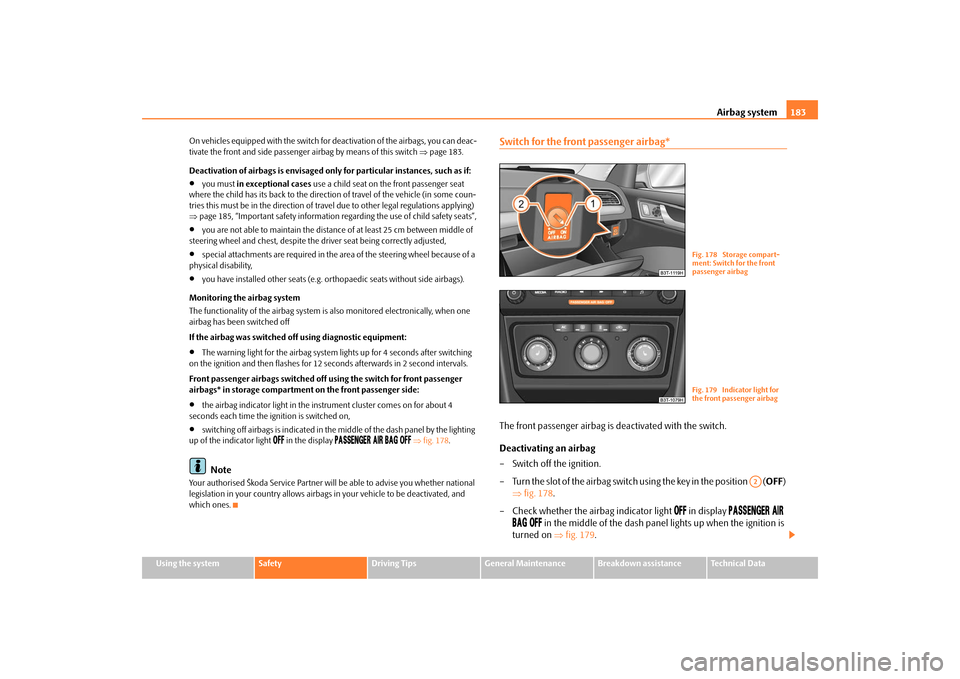
Airbag system
183
Using the system
Safety
Driving Tips
General Maintenance
Breakdown assistance
Technical Data
On vehicles equipped with the switch for deactivation of the airbags, you can deac- tivate the front and side passenger airbag by means of this switch
⇒page 183.
Deactivation of airbags is envisaged only
for particular inst
ances, such as if:
•
you must
in exceptional cases
use a child seat on the front passenger seat
where the child has its back to the directio
n of travel of the ve
hicle (in some coun-
tries this must be in the direction of travel due to other legal regulations applying) ⇒ page 185, “Important safety information regarding the use of child safety seats”,•
you are not able to maintain the distance
of at least 25 cm between middle of
steering wheel and chest, despite the driver seat being correctly adjusted,•
special attachments are required in the area of the steering wheel because of a
physical disability,•
you have installed other seats (e.g. orthopaedic seats without side airbags).
Monitoring the airbag system The functionality of the airbag system is also monitored electronically, when one airbag has been switched off If the airbag was switched of
f using diagnostic equipment:
•
The warning light for the airbag system
lights up for 4 seconds after switching
on the ignition and then flashes for 12 seconds afterwards in 2 second intervals. Front passenger airbags switched off
using the switch for front passenger
airbags* in storage compartmen
t on the front passenger side:
•
the airbag indicator light in the inst
rument cluster comes on for about 4
seconds each time the ig
nition is switched on,
•
switching off airbags is indicated in the middle of the dash panel by the lighting
up of the indicator light
in the display
⇒fig. 178
.
Note
Your authorised Škoda Service Partner will
be able to advise
you whether national
legislation in your country allows airbags
in your vehicle to
be deactivated, and
which ones.
Switch for the front passenger airbag*The front passenger airbag is deactivated with the switch. Deactivating an airbag – Switch off the ignition. – Turn the slot of the airbag switch using the key in the position (
OFF
)
⇒
fig. 178
.
– Check whether the airbag indicator light
in display
in the middle of the dash panel
lights up when the ignition is
turned on
⇒
fig. 179
.
Fig. 178 Storage compart- ment: Switch for the front passenger airbagFig. 179 Indicator light for the front passenger airbag
A2
s2dk.1.book Page 183 Wednesday, April 8, 2009 12:23 PM
Page 185 of 294
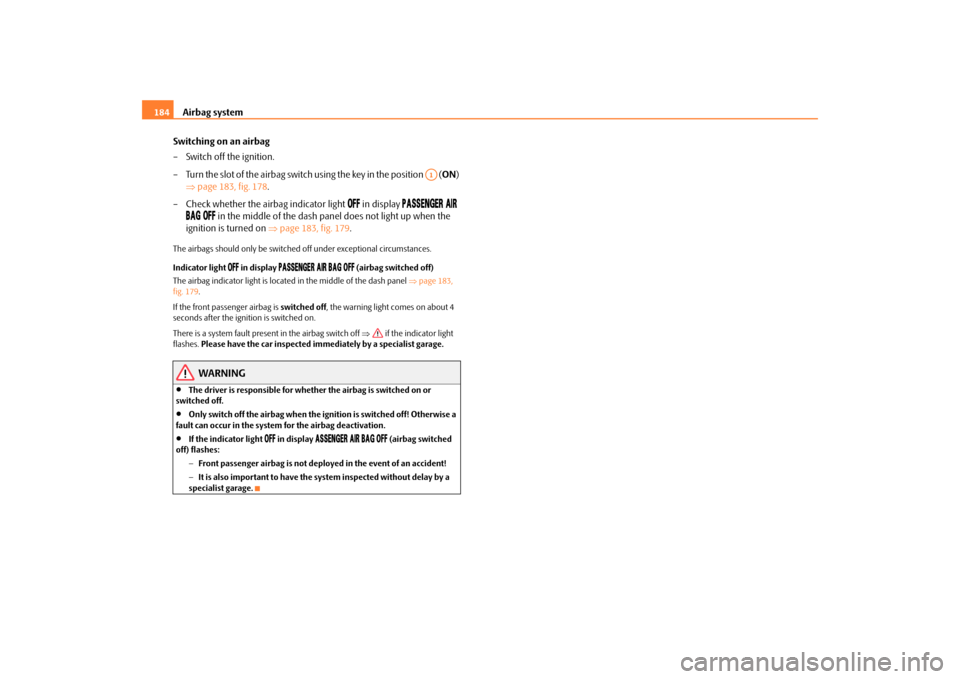
Airbag system
184
Switching on an airbag – Switch off the ignition. – Turn the slot of the airbag switch using the key in the position (
ON
)
⇒
page 183, fig. 178
.
– Check whether the airbag indicator light
in display
in the middle of the dash pa
nel does not light up when the
ignition is turned on
⇒
page 183, fig. 179
.
The airbags should only be switched
off under exceptional circumstances.
Indicator light
in display
(airbag switched off)
The airbag indicator light is located in the middle of the dash panel
⇒page 183,
fig. 179
.
If the front passenger airbag is
switched off
, the warning light comes on about 4
seconds after the igniti
on is switched on.
There is a system fault present in the airbag switch off
⇒
if the indicator light
flashes.
Please have the car inspected i
mmediately by a sp
ecialist garage.
WARNING
•
The driver is responsible for whethe
r the airbag is switched on or
switched off.•
Only switch off the airbag when the ignition is switched off! Otherwise a
fault can occur in the system for the airbag deactivation.•
If the indicator light
in display
(airbag switched
off) flashes:
− Front passenger airbag is not deployed in the event of an accident! − It is also important to have the system inspected without delay by a specialist garage.
A1
s2dk.1.book Page 184 Wednesday, April 8, 2009 12:23 PM
Page 194 of 294

Intelligent Technology
193
Using the system
Safety
Driving Tips
General Maintenance
Breakdown assistance
Technical Data
Driving TipsIntelligent TechnologyElectronic stability programme (ESP)*GeneralGeneral The ESP aids you maintain control of your vehicle in situations in borderline driving situations such as when negotiating a curve too fast. The risk of skidding is reduced and your car thus offers greater driving stability depending on the conditions of the road surface. This occurs at all speeds. The following systems are integrated into the electronic stability programme:•
Electronic Differential Lock (EDL),
•
Traction control system (TCS),
•
Active driver-steering recommendation (DSR),
•
Antilock brake system (ABS),
•
Brake Assist,
•
Uphill-Start off-Assist.
Operating principle The ESP switches on automatically when the engine is started and then conducts a self-test. The ESP control unit processes data from the individual systems. It also processes additional measurement data which are supplied by highly sensitive sensors: the rotational velocity of the vehi
cle about its vertical axis, the lateral accel-
eration of the vehicle, the brakin
g pressure and the steering angle.
The direction which the driver wishes to ta
ke is determined based on the steering
angle and the speed of the vehicle and is constantly compared with the actual behaviour of the vehicle. If differences exis
t, such as the car beginning to skid, the
ESP will automatically brake the appropriate wheel. The car is stabilised again by the forces which take effect when the wheel is braked. Intervention into the brake system takes place primarily on the outer front wheel of a vehicle which tends to oversteer (tendency for the rear of the vehicle to break away) while occurs this is on the inner re
ar wheel of a vehicle which tends to under-
steer (tendency to shift out of the curve). This braking control cycle is accompanied by noises. The ESP operates in combination with the ABS
⇒page 197. If there is a fault in the
ABS system, the ESP also does not operate. The ESP warning light lights up in the instru
ment cluster when there is a fault on the
ESP
⇒page 39.
Switching off You can switch the ESP off and on again
as you wish, by pressing the button
⇒ fig. 190
. The ESP warning light lights up in th
e instrument cluster when the ESP is
switched off
⇒page 39.
The ESP should normally always be switched
on. It may be good practice in certain
exceptional cases, such as when you wish
to have wheel slip, to switch off the
system. Examples:
Fig. 190 ESP switch
s2dk.1.book Page 193 Wednesday, April 8, 2009 12:23 PM
Page 195 of 294
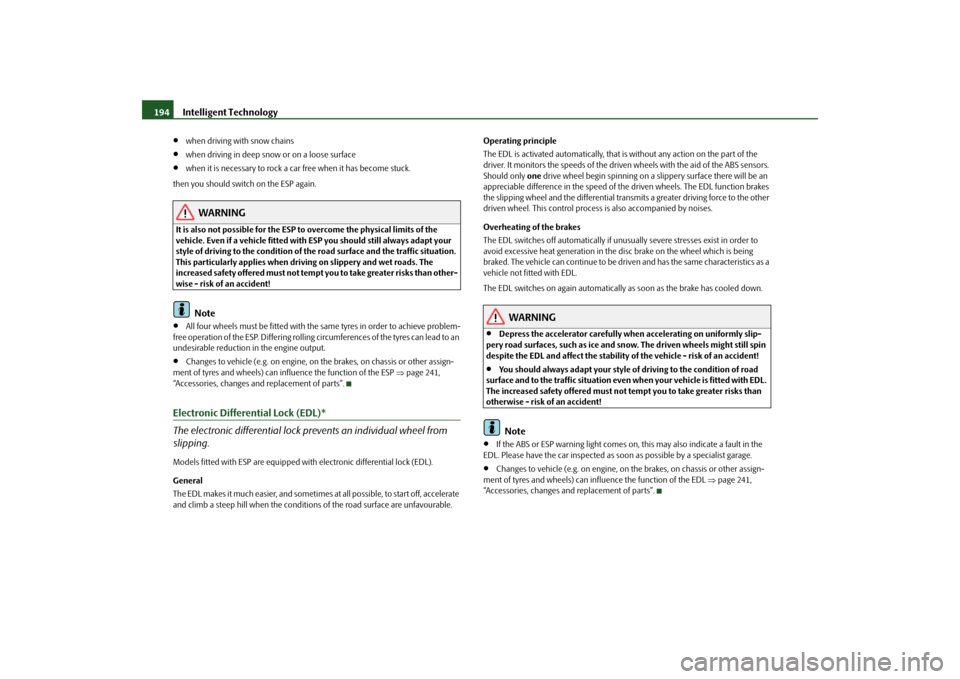
Intelligent Technology
194
•
when driving with snow chains
•
when driving in deep snow or on a loose surface
•
when it is necessary to rock a ca
r free when it has become stuck.
then you should switch on the ESP again.
WARNING
It is also not possible for the ESP to overcome the physical limits of the vehicle. Even if a vehicle fitted with ESP you should still always adapt your style of driving to the condition of the
road surface and the traffic situation.
This particularly applies when driving on slippery and wet roads. The increased safety offered must not tempt you to take greater risks than other- wise - risk of an accident!
Note
•
All four wheels must be fitted with the same tyres in order to achieve problem-
free operation of the ESP. Differing rolling
circumferences of the tyres can lead to an
undesirable reduction in the engine output.•
Changes to vehicle (e.g. on engine, on the brakes, on chassis or other assign-
ment of tyres and wheels) can influence the function of the ESP
⇒page 241,
“Accessories, changes and replacement of parts”.Electronic Differential Lock (EDL)* The electronic differential lock pr
events an individual wheel from
slipping.Models fitted with ESP are equipped with electronic differential lock (EDL). General The EDL makes it much easier, and sometimes at all possible, to start off, accelerate and climb a steep hill when the conditio
ns of the road surface are unfavourable.
Operating principle The EDL is activated automatically, that is
without any action on the part of the
driver. It monitors the speeds of the driven wheels with the aid of the ABS sensors. Should only
one
drive wheel begin spinning on a slippery surface there will be an
appreciable difference in the speed of the driven wheels. The EDL function brakes the slipping wheel and the differential transmits a greater driving force to the other driven wheel. This control proces
s is also accompanied by noises.
Overheating of the brakes The EDL switches off
automatically if unusually severe
stresses exist in order to
avoid excessive heat generation in the
disc brake on the wheel which is being
braked. The vehicle can continue to be driv
en and has the same characteristics as a
vehicle not fitted with EDL. The EDL switches on again
automatically as soon as the brake has cooled down.
WARNING
•
Depress the accelerator carefully when accelerating on uniformly slip-
pery road surfaces, such as ice and sn
ow. The driven wheels might still spin
despite the EDL and affect the stability
of the vehicle - risk of an accident!
•
You should always adapt your style of driving to the condition of road
surface and to the traffic situation even
when your vehicle is fitted with EDL.
The increased safety offered must not tempt you to take greater risks than otherwise - risk of an accident!
Note
•
If the ABS or ESP warning light comes on,
this may also indicate a fault in the
EDL. Please have the car inspected as s
oon as possible by a specialist garage.
•
Changes to vehicle (e.g. on engine, on
the brakes, on chassis or other assign-
ment of tyres and wheels) can in
fluence the function of the EDL
⇒page 241,
“Accessories, changes and
replacement of parts”.
s2dk.1.book Page 194 Wednesday, April 8, 2009 12:23 PM
Page 196 of 294
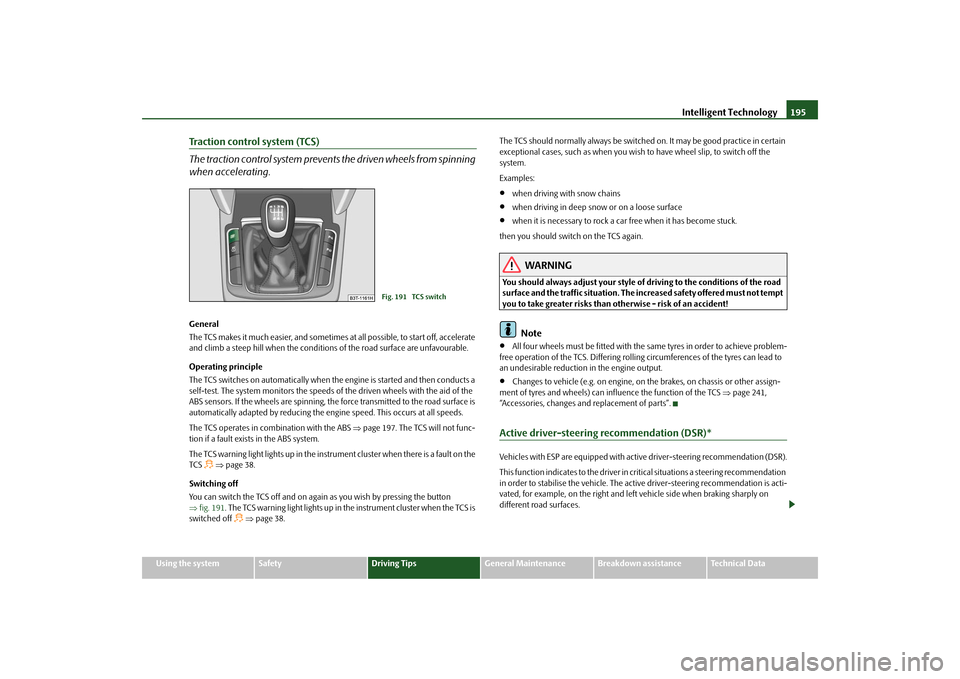
Intelligent Technology
195
Using the system
Safety
Driving Tips
General Maintenance
Breakdown assistance
Technical Data
Traction control system (TCS) The traction control system prevents
the driven wheels from spinning
when accelerating.General The TCS makes it much easier, and sometimes at all possible, to start off, accelerate and climb a steep hill when the conditio
ns of the road surface are unfavourable.
Operating principle The TCS switches on automatically when th
e engine is started and then conducts a
self-test. The system monitors the speeds of the driven wheels with the aid of the ABS sensors. If the wheels are spinning, the force transmitted to the road surface is automatically adapted by redu
cing the engine speed. Th
is occurs at all speeds.
The TCS operates in combination with the ABS
⇒page 197. The TCS will not func-
tion if a fault exists in the ABS system. The TCS warning light lights up in the instrument cluster when there is a fault on the TCS
⇒page 38.
Switching off You can switch the TCS off and on again
as you wish by pressing the button
⇒ fig. 191
. The TCS warning light lights up in the instrument cluster when the TCS is
switched off
⇒page 38.
The TCS should normally always be switched on. It may be good practice in certain exceptional cases, such as when you wish
to have wheel slip, to switch off the
system. Examples:•
when driving with snow chains
•
when driving in deep snow or on a loose surface
•
when it is necessary to rock a car free when it has become stuck.
then you should switch on the TCS again.
WARNING
You should always adjust your style of driving to the conditions of the road surface and the traffic situation. The increased safety offered must not tempt you to take greater risks than otherwise - risk of an accident!
Note
•
All four wheels must be fitted with the same tyres in order to achieve problem-
free operation of the TCS. Differing rolling circumferences of the tyres can lead to an undesirable reduction in the engine output.•
Changes to vehicle (e.g. on engine, on the brakes, on chassis or other assign-
ment of tyres and wheels) can in
fluence the function of the TCS
⇒page 241,
“Accessories, changes and replacement of parts”.Active driver-steering recommendation (DSR)*Vehicles with ESP are equi
pped with active driver-steering recommendation (DSR).
This function indicates to the driver in critical situations a steering recommendation in order to stabilise the vehicle. The active driver-steering recommendation is acti- vated, for example, on the right and left
vehicle side when
braking sharply on
different road surfaces.
Fig. 191 TCS switch
s2dk.1.book Page 195 Wednesday, April 8, 2009 12:23 PM
Page 197 of 294
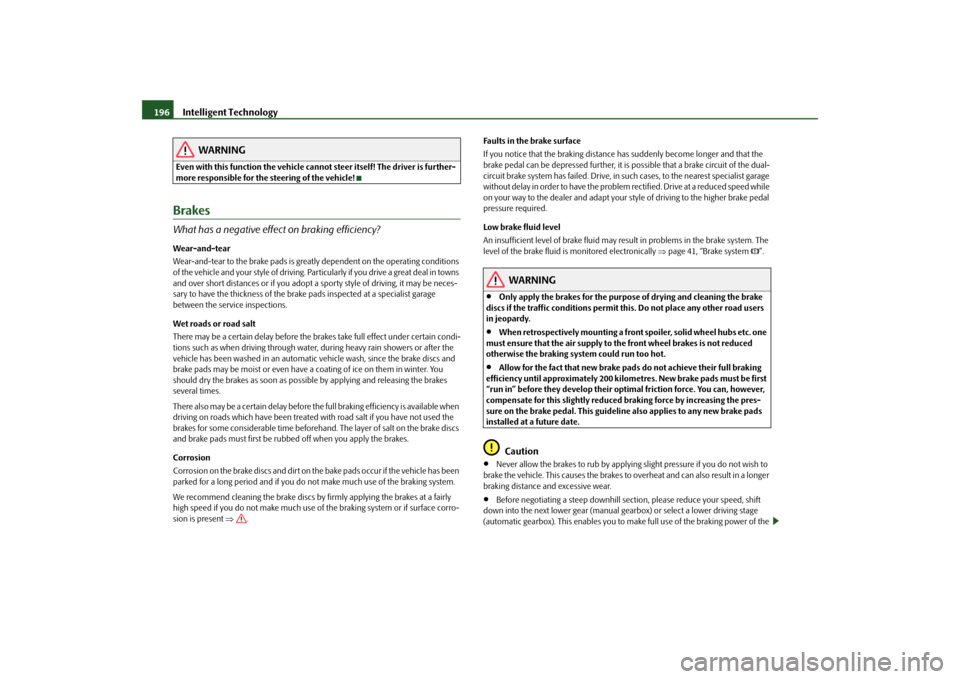
Intelligent Technology
196
WARNING
Even with this function the vehicle ca
nnot steer itself! The
driver is further-
more responsible for the steering of the vehicle!BrakesWhat has a negative effect on braking efficiency?Wear-and-tear Wear-and-tear to the brake pads is greatly dependent on the operating conditions of the vehicle and your style of driving. Particularly if you drive a great deal in towns and over short distances or if you adopt a
sporty style of driving, it may be neces-
sary to have the thickness of the brake
pads inspected at a specialist garage
between the service inspections. Wet roads or road salt There may be a certain delay before the br
akes take full effect under certain condi-
tions such as when driving through water,
during heavy rain
showers or after the
vehicle has been washed in
an automatic vehicle wash, since the brake discs and
brake pads may be moist or even have a
coating of ice on them in winter. You
should dry the brakes as soon as possib
le by applying and releasing the brakes
several times. There also may be a certain delay before the
full braking efficiency is available when
driving on roads which have been treated wi
th road salt if yo
u have not used the
brakes for some considerable time beforeha
nd. The layer of salt on the brake discs
and brake pads must first be rubb
ed off when you apply the brakes.
Corrosion Corrosion on the brake discs and dirt on th
e bake pads occur if
the vehicle has been
parked for a long period and if you do
not make much use of the braking system.
We recommend cleaning the brake discs by
firmly applying the brakes at a fairly
high speed if you do not make much use of the braking system or if surface corro- sion is present
⇒
.
Faults in the brake surface If you notice that the braking distance
has suddenly become longer and that the
brake pedal can be depressed further, it is
possible that a brake circuit of the dual-
circuit brake system has failed. Drive, in such cases, to the nearest specialist garage without delay in order to have the problem rectified. Drive at a reduced speed while on your way to the dealer and adapt your style of driving to the higher brake pedal pressure required. Low brake fluid level An insufficient level of brake fluid may result in problems in the brake system. The level of the brake fluid is monitored electronically
⇒page 41, “Brake system
”.
WARNING
•
Only apply the brakes for the purpos
e of drying and cleaning the brake
discs if the traffic conditions permit this. Do not place any other road users in jeopardy.•
When retrospectively mounting a front
spoiler, solid wheel hubs etc. one
must ensure that the air supply to the front wheel brakes is not reduced otherwise the braking sy
stem could run too hot.
•
Allow for the fact that new brake pads
do not achieve th
eir full braking
efficiency until approximately 200 kilo
metres. New brake pads must be first
“run in” before they develop their optimal friction force. You can, however, compensate for this slightly reduced
braking force by increasing the pres-
sure on the brake pedal. This guidelin
e also applies to any new brake pads
installed at a future date.
Caution
•
Never allow the brakes to ru
b by applying slig
ht pressure if you do not wish to
brake the vehicle. This causes the brakes to overheat and can also result in a longer braking distance and excessive wear.•
Before negotiating a steep downhill sect
ion, please reduce your speed, shift
down into the next lower gear (manual ge
arbox) or select a lower driving stage
(automatic gearbox). This enables you to make full use of the braking power of the
s2dk.1.book Page 196 Wednesday, April 8, 2009 12:23 PM
Page 198 of 294

Intelligent Technology
197
Using the system
Safety
Driving Tips
General Maintenance
Breakdown assistance
Technical Data
vehicle and reduces the strain on the brakes
. Any additional braking should be done
intermittently, no
t continuously.
Note
The brake light flashes automa
tically in case of an em
ergency braking at speeds
g re a t e r t h a n 6 0 k m /h o r w i t h t he i n t e r v e n t i o n o f th e A BS , w h i ch l a s t s l o n g e r th a n 1 .5 seconds. After the speed was reduced belo
w 10 km/h or the vehicle was stopped,
the brake light stops flashing and the hazard warning light system switches on. The hazard warning light system is switched
off automatically after accelerating or
driving off again.Brake boosterThe brake booster boosts the pressure which you generate with the brake pedal. The necessary pressure is only gene
rated when the engine is running.
WARNING
•
Never switch off the engine before the vehicle is stationary.
•
The brake booster only operates when the engine is running. Greater
physical effort for braking is required
when engine is switched off. Because
if you do not stop as normal, this can cause an accident and severe injuries.Antilock brake system (ABS)ABS prevents the wheels locking when braking.General The ABS contributes significan
tly to enhancing the active
safety of your vehicle.
Compared to a car not fitted with the ABS brake system, you are able to retain optimal steering ability even during a fu
ll brake application on a slippery road
surface because the wheels do not lock up. You must not expect, however, that the br
aking distance will be shorter under all
circumstances as a result of the ABS. Th
e braking distance for example on gravel
and fresh snow, when you should anyway be driving slowly and cautiously, will be longer. Operating principle The brake pressure will be reduced on a wheel which is rotating at a speed which is too low for the speed of the vehicle and tend
ing to lock. This control cycle is notice-
able from a
pulsating movement of the brake pedal
which is accompanied by
noises. This is consciously intended to provide the driver with the information that the wheels are tending to lock (ABS control range). You must always keep the brake pedal depressed to enable the ABS to optima
lly control the brake application in this
braking range. Never interrupt the application of the brakes!
WARNING
•
The ABS can also not overcome the physic
al limits of your vehicle. Please
do not forget this, particularly when driv
ing on icy or wet road surfaces. If the
ABS is operating within the control ra
nge, adapt your speed immediately to
the conditions of the road surface and the traffic situation. The increased safety offered by the ABS must not tempt you to take greater risks than otherwise - risk of an accident!•
The normal braking system is still fully
functional if there is an ABS fault.
Visit a specialist garage as quickly as po
ssible and adjust yo
ur style of driving
to take account of the ABS fault in the meantime since you will not know how great the damage is.
Note
•
A warning light comes on if a fault occurs in the ABS system
⇒page 39.
•
Changes to vehicle (e.g. on engine, on the brakes, on chassis or other assign-
ment of tyres and wheels) can in
fluence the function of the ABS
⇒page 241,
“Accessories, changes and replacement of parts”.
s2dk.1.book Page 197 Wednesday, April 8, 2009 12:23 PM
Page 199 of 294

Intelligent Technology
198
Brake Assist*During a severe brake application (e.g. if a hazard exists), the Brake Assist increases the braking force and thus makes it possible to rapidly produce the pressure required in the brake system. The majority of drivers do
apply the brakes in good time in dangerous situations,
but do not depress the brake pedal with su
fficient pressure. Consequently, it is not
possible for the car to achieve its maxi
mum deceleration and the car covers a
greater distance than necessary. The Brake Assist is activated by the very quick operation of the brake pedal. In such cases, a much greater braking pressure ex
ists than during a normal brake applica-
tion. This makes it possible, even with a relatively low resistance of the brake pedal, to produce an adequate pressure in the brake system in the shortest possible time, which is required for maximum deceleration of the car. You must apply the brake pedal firmly and hold it in
this position in order to achieve the shortest possible
braking distance. The Brake Assist is able to help you achieve a shorter braking distance in emergency situations by rapidly producing the pressure
required in the brake system. It fully
exploits the attributes of the ABS. After you release the brake pedal, the function of the Brake Assist is automatically switched off and the brakes operate in the normal way. The Brake Assist is part of the ESP system. If a fault occurs in the ESP, the Brake Assist function is also not available.
Further information on the ESP
⇒page 193.
WARNING
•
The Brake Assist is also not able to overcome the physical limits of your
car in terms of the braking distance required.•
Adapt your speed to the conditions of the road surface and to the traffic
situation.•
The increased safety offered by the Brake Assist must not tempt you to
take a greater safety risk than otherwise.
Uphill-Start
off-Assist*
The uphill-start off-assist makes it much easier to start off on steep hills. The system assists a start off by holding the brake pr
essure produced by the brake pedal actu-
ation for approx. 2 seconds after releasing the brake pedal. The driver can therefore move his foot from the brake pedal to th
e accelerator pedal and start off on the
slope, without having to actuate the hand
brake. The brake pressure drops gradually
the more you operate the accelerator pedal. If the vehicle does not start off within 2 seconds, it starts to roll back. The uphill-start off-assist is active in the ev
ent of a 5% slope, if the vehicle door is
closed. It is alwa
ys active on slopes when in forward or reverse start off. When
driving downhill, it is inactive.Electromechanical power steeringThe power steering enables you to steer
the vehicle with le
ss physical force.
With the electromechanical power steering, the steering assist is automatically adapted to the speed and to the steering angle. It is still possible to fully steer the vehicle if the power steering fails or if the engine is not running (vehicle being towed in). The
only difference is that greater physical
effort is required. If there is a fault in the power steering, the warning light
or lights up in the
instrument cluster
⇒page 36.
WARNING
Contact your specialist
garage if the power steering is defective.
s2dk.1.book Page 198 Wednesday, April 8, 2009 12:23 PM
Page 200 of 294
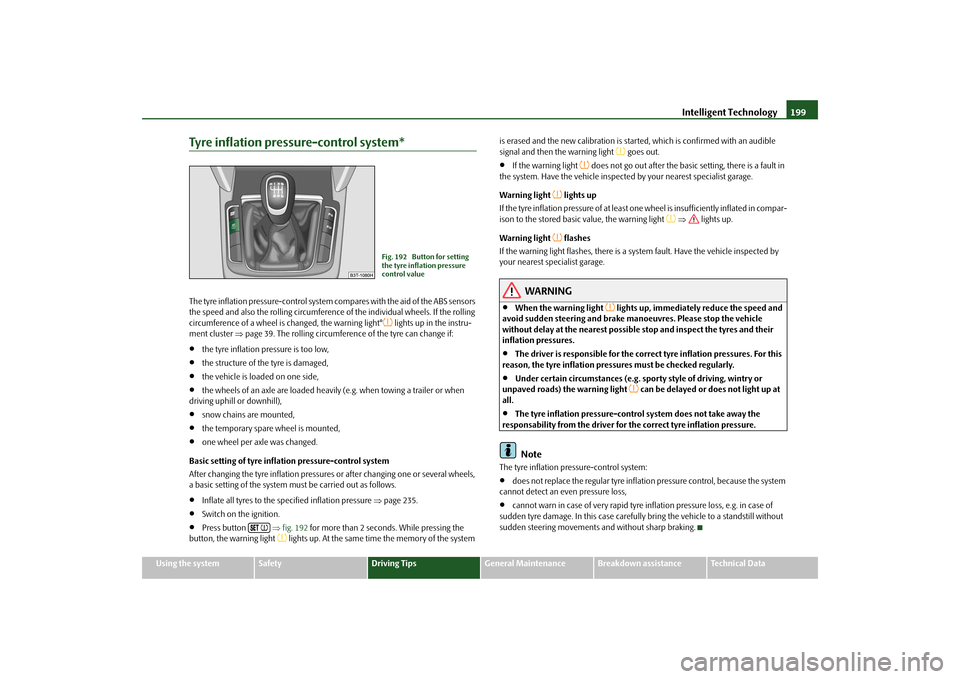
Intelligent Technology
199
Using the system
Safety
Driving Tips
General Maintenance
Breakdown assistance
Technical Data
Tyre inflation pressu
re-control system*
The tyre inflation pressure-control system compares with the aid of the ABS sensors the speed and also the rolling circumference
of the individual wheels. If the rolling
circumference of a wheel is changed, the warning light°
lights up in the instru-
ment cluster
⇒page 39. The rolling circumference of the tyre can change if:
•
the tyre inflation pressure is too low,
•
the structure of the tyre is damaged,
•
the vehicle is loaded on one side,
•
the wheels of an axle are loaded heavily (e.g. when towing a trailer or when
driving uphill or downhill),•
snow chains are mounted,
•
the temporary spare wheel is mounted,
•
one wheel per axle was changed.
Basic setting of tyre inflation pressure-control system After changing the tyre inflation pressures or after changing one or several wheels, a basic setting of the system must be carried out as follows.•
Inflate all tyres to the specified inflation pressure
⇒page 235.
•
Switch on the ignition.
•
Press button
⇒fig. 192
for more than 2 seconds. While pressing the
button, the warning light
lights up. At the same time the memory of the system
is erased and the new calibration is star
ted, which is confirmed with an audible
signal and then the warning light
goes out.
•
If the warning light
does not go out after the basic setting, there is a fault in
the system. Have the vehicle inspected by your nearest specialist garage. Warning light
lights up
If the tyre inflation pressure of at least on
e wheel is insufficiently inflated in compar-
ison to the stored basic value, the warning light
⇒
lights up.
Warning light
flashes
If the warning light flashes, there is a system fault. Have the vehicle inspected by your nearest specialist garage.
WARNING
•
When the warning light
lights up, immediately reduce the speed and
avoid sudden steering and brake mano
euvres. Please stop the vehicle
without delay at the nearest possible stop and inspect the tyres and their inflation pressures.•
The driver is responsible for the correc
t tyre inflation pressures. For this
reason, the tyre inflation pressures must be checked regularly.•
Under certain circumstances (e.g. sporty style of driving, wintry or
unpaved roads) the warning light
can be delayed or does not light up at
all.•
The tyre inflation pressure-control system does not take away the
responsability from the driver for the correct tyre inflation pressure.
Note
The tyre inflation pressure-control system:•
does not replace the regular tyre inflatio
n pressure control, because the system
cannot detect an even pressure loss,•
cannot warn in case of very rapid tyre inflation pressure loss, e.g. in case of
sudden tyre damage. In this
case carefully bring the vehi
cle to a standstill without
sudden steering movements and without sharp braking.
Fig. 192 Button for setting the tyre inflation pressure control value
s2dk.1.book Page 199 Wednesday, April 8, 2009 12:23 PM